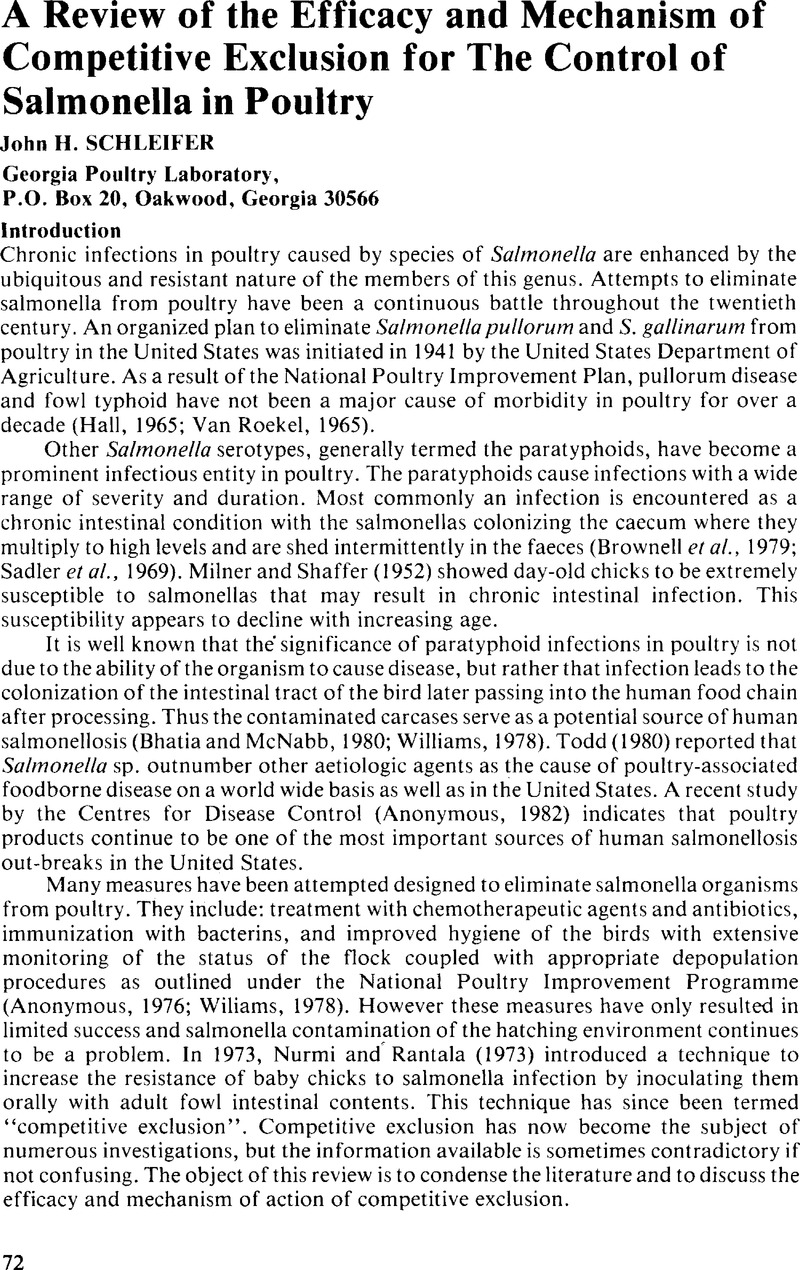Crossref Citations
This article has been cited by the following publications. This list is generated based on data provided by Crossref.
Stavric, Stanislava
1992.
Defined cultures and prospects.
International Journal of Food Microbiology,
Vol. 15,
Issue. 3-4,
p.
245.
Schneitz, C.
Nuotio, L.
and
Lounatma, K.
1993.
Adhesion of Lactobacillus acidophilus to avian intestinal epithelial cells mediated by the crystalline bacterial cell surface layer (S‐layer).
Journal of Applied Bacteriology,
Vol. 74,
Issue. 3,
p.
290.
MCKELLAR, R. C.
MODLER, H. W.
and
MULLIN, J.
1993.
Characterization of Growth and Inulinase Production by Bifidobacterium spp. on Fructooligosaccharides.
Bifidobacteria and Microflora,
Vol. 12,
Issue. 2,
p.
75.
ROSE, S. M.
MODLER, H. W.
and
MCKELLAR, R. C.
1994.
Bifidobacteria in Broiler Starter Rations: Factors Affecting Survival.
Bifidobacteria and Microflora,
Vol. 13,
Issue. 1,
p.
17.
Modler, H.Wayne
1994.
Bifidogenic factors—sources, metabolism and applications.
International Dairy Journal,
Vol. 4,
Issue. 5,
p.
383.
Hassan, J O
and
Curtiss, R
1994.
Development and evaluation of an experimental vaccination program using a live avirulent Salmonella typhimurium strain to protect immunized chickens against challenge with homologous and heterologous Salmonella serotypes.
Infection and Immunity,
Vol. 62,
Issue. 12,
p.
5519.
STERN, NORMAN J.
1994.
Mucosal Competitive Exclusion to Diminish Colonization of Chickens by Campylobacter jejuni.
Poultry Science,
Vol. 73,
Issue. 3,
p.
402.
OYARZABAL, OMAR A.
and
CONNER, DONALD E.
1995.
In Vitro Fructooligosaccharide Utilization and Inhibition of Salmonella spp. by Selected Bacteria.
Poultry Science,
Vol. 74,
Issue. 9,
p.
1418.
Jin, L.Z.
Ho, Y.W.
Abdullah, N.
and
Jalaludin, S.
1997.
Probiotics in poultry: modes of action.
World's Poultry Science Journal,
Vol. 53,
Issue. 4,
p.
351.
CRANDER, RAMESH
RAJMANE, B.V.
and
THOMAS, PAUL
1997.
CONTROL OF SALMONELLA IN POULTRY BY RADIOVACCINE.
Journal of Food Safety,
Vol. 17,
Issue. 4,
p.
223.
Hofacre, Charles L.
Primm, Nicholas D.
Vance, Kristen
Goodwin, Mark A.
and
Brown, John
2000.
Comparison of a Lyophilized Chicken-Origin Competitive Exclusion Culture, a Lyophilized Probiotic, and Fresh Turkey Cecal Material Against Salmonella Colonization.
Journal of Applied Poultry Research,
Vol. 9,
Issue. 2,
p.
195.
Zhu, Xiang Y.
Zhong, Tanya
Pandya, Yoga
and
Joerger, Rolf D.
2002.
16S rRNA-Based Analysis of Microbiota from the Cecum of Broiler Chickens.
Applied and Environmental Microbiology,
Vol. 68,
Issue. 1,
p.
124.
Fernandez, F.
Hinton, M.
and
Gils, B. Van
2002.
Dietary mannan-oligosaccharides and their effect on chicken caecal microflora in relation to Salmonella Enteritidis colonization.
Avian Pathology,
Vol. 31,
Issue. 1,
p.
49.
Schneitz, C.
and
Renney, D. J.
2003.
Effect of a Commerical Competitive Exclusion Product on the Colonization of Salmonella infantis in Day-Old Pheasant Chicks.
Avian Diseases,
Vol. 47,
Issue. 4,
p.
1448.
Ricke, Steven C.
Woodward, Casendra L.
Kwon, Young Min
Kubena, Leon F.
and
Nisbet, David J.
2004.
Preharvest and Postharvest Food Safety.
p.
141.
Schneitz, Carita
2005.
Competitive exclusion in poultry––30 years of research.
Food Control,
Vol. 16,
Issue. 8,
p.
657.
Klose, Viviana
Mohnl, Michaela
Plail, Regina
Schatzmayr, Gerd
and
Loibner, Andreas‐Paul
2006.
Development of a competitive exclusion product for poultry meeting the regulatory requirements for registration in the European Union.
Molecular Nutrition & Food Research,
Vol. 50,
Issue. 6,
p.
563.
Schneitz, Carita
and
Mead, Geoffrey
2010.
Handbook of Poultry Science and Technology.
p.
19.
Roto, Stephanie M.
Rubinelli, Peter M.
and
Ricke, Steven C.
2015.
An Introduction to the Avian Gut Microbiota and the Effects of Yeast-Based Prebiotic-Type Compounds as Potential Feed Additives.
Frontiers in Veterinary Science,
Vol. 2,
Issue. ,
Roto, Stephanie M.
Kwon, Young Min
and
Ricke, Steven C.
2016.
Applications of In Ovo Technique for the Optimal Development of the Gastrointestinal Tract and the Potential Influence on the Establishment of Its Microbiome in Poultry.
Frontiers in Veterinary Science,
Vol. 3,
Issue. ,





